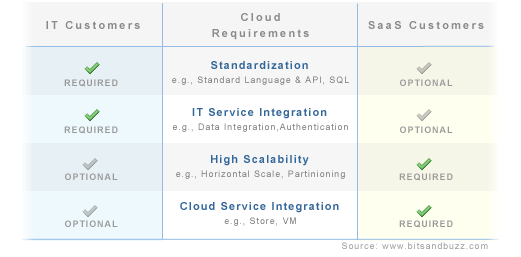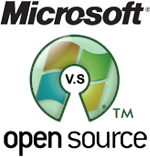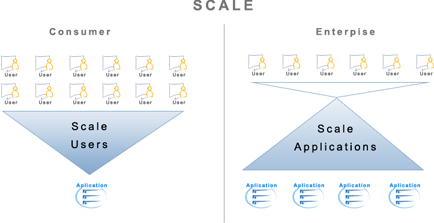Cloud Portability: Force.com vs Google App Engine vs Amazon
September 16th, 2009 by jeremychone | Comments OffOne of the biggest fears of any IT manager about cloud computing is the lack of openness. In other words, they ask, “How easy is it to get in and out? Or they might ask, “How portable is a cloud application?”
Ideally, enterprises should be able to take applications and data in or out of a cloud as business requires without having to rewrite the application or transform the data.
As discussed in the article “Don’t Get Stuck in a Cloud ,” cloud portability tends to be a factor related to the type of cloud one uses.
Here is a quick portability analysis of the three big Clouds on the market:



 If you are lucky, and curious enough, Oracle can be the best place to learn the enterprise software market. I have worked at Oracle for about seven years and, in my entire career, it is where I have learned the most about enterprise software. When Oracle announced it was buying Sun, I was actually not that surprised, and I thought it was to be expected after the IBM escape. Oracle is in a self-fulfilling prophecy to consolidate the enterprise software market and, after IBM turned down what could have been a great match for open source and Java, Oracle had to jump in. Larry Ellison and
If you are lucky, and curious enough, Oracle can be the best place to learn the enterprise software market. I have worked at Oracle for about seven years and, in my entire career, it is where I have learned the most about enterprise software. When Oracle announced it was buying Sun, I was actually not that surprised, and I thought it was to be expected after the IBM escape. Oracle is in a self-fulfilling prophecy to consolidate the enterprise software market and, after IBM turned down what could have been a great match for open source and Java, Oracle had to jump in. Larry Ellison and 
 For a commercial entity, building an effective open source strategy can be a relatively daunting task. Open Source strategy discussions tend to revolve around licensing. Typical questions are, ”Should we use dual licensing?,” “Should we use GPL or BSD?,” “What are the risks of GPL?,” “Can the licensing help us drive users to our commercial assets?,” or “What are the competitive risk associated with each type of license?“
For a commercial entity, building an effective open source strategy can be a relatively daunting task. Open Source strategy discussions tend to revolve around licensing. Typical questions are, ”Should we use dual licensing?,” “Should we use GPL or BSD?,” “What are the risks of GPL?,” “Can the licensing help us drive users to our commercial assets?,” or “What are the competitive risk associated with each type of license?“ In the last few years, the technology industry has been particularly focused on Web developers, and the last couple of weeks have been a relatively good example of such attention. First, Adobe released its Adobe AIR and their Flex 3 products; Microsoft did a massive
In the last few years, the technology industry has been particularly focused on Web developers, and the last couple of weeks have been a relatively good example of such attention. First, Adobe released its Adobe AIR and their Flex 3 products; Microsoft did a massive  In the last couple of weeks Microsoft has been pretty loud around the "new Internet wave." First, with the announcement of
In the last couple of weeks Microsoft has been pretty loud around the "new Internet wave." First, with the announcement of